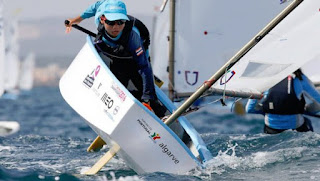Will the RS Aero Dethrone the Laser for the 2024 Olympics?
 World Sailing released today the much-awaited report of the Evaluation Panel of its Equipment Committee for the selection of a single-hander dinghy for the 2024 Olympics.
World Sailing released today the much-awaited report of the Evaluation Panel of its Equipment Committee for the selection of a single-hander dinghy for the 2024 Olympics.The report favors the RS Aero, yet the Laser is also seen as suitable.
This is not yet a final decision by World Sailing, as the decision will be made by the World Sailing Council.
There will be lots of pressure for the Laser to be kept, despite its significantly lower score.
Will the two discarded contenders be given a chance to comment on the report and possibly bring the World Sailing Council to consider them for 2024?
The report is just out, but one can already suggest this report is a missed opportunity.
For example, it is well-known that the Laser Radial is not a suitable boat for a majority of female sailors world-wide, because too powerful. This is recognized in the report, which mentions for the Laser that "the women’s rig promotes a larger weight and height than desirable for worldwide average women."
Yet, the RS Aero, with its 7 square meter sail for female sailors, is described as geared towards "higher crew ranges." The ideal sailor weight range is estimated at 68 to 73 kg for the RS Aero (7 rig) v. 67 to 71 kg for the Laser Radial, i.e. is estimated as even higher for the RS Aero 7 than for the Laser Radial (see chart below)
A solution for this would be to have a smaller sail on the RS Aero - such as 6 square meters sail - but that is not mentioned in the report. This is something that World Sailing could still require RS Sailing to implement and would have the potential to make single-handed sailing much more popular with female sailors.
For the Laser, there is no obvious solution to address this, given the much higher hull weight. The 4.7 is a successful youth development boat, but has never developped any significant fleets of senior or master female sailors.
What was not part of the trial, but may offer a solution with the Laser to better suit female sailors, are the new 29er like rigs developped in Australia (C5, C6 in particular) but this was not accepted by World Sailing for testing at the Valencia trials.
Another key issue is that of imposing the same boat for male and female sailors. That is unfortunately something that World Sailing stipulated in its tender documents. But why? Doesn't it mean either perpetuating, or replacing, a quasi-monopoly? Having two different boats for male and female sailors would make lots of sense.
Talking about monopoly / competition, RS Aeros are presently manufactured by a single builder in the UK, while the Laser is now manufactured by 2 builders only, in Australia and Japan, as the Laser's dominant manufacturer - LaserPerformance - was recently decertified, and it's unclear if/when there will be new Laser builders.
And the Lasers tested in Valencia by World Sailing were manufactured by LaserPerformance ...
We will provide a detailed analysis in the next few days.
See the report here:
http://www.sailing.org/tools/documents/EQCSP4biiiMenWomenOnePersonDinghy-[24944].pdf
See a detailed analysis of the report,
https://optimist-openbic-sailing.blogspot.com/2019/05/evaluation-of-singlehanders-by-world.html
and practical recommendations.
https://optimist-openbic-sailing.blogspot.com/2019/05/evaluation-of-singlehanders-by-world_11.html
Executive Summary
The Evaluation Panel exchanged multiple emails in the past 3 months, met multiple times via web conference and spent 5 days together during the Sea Trials hosted in the Real Club Naútico de Valencia, in Spain, evaluating the equipment options.
The evaluation considers information available from the Re-evaluation tender process (which includes documentation and feedback from boat production facility visits), and information from the Sea Trials (which includes presentations from the candidates, feedback from MNA Sailors, the Coach and the Evaluation Panel members, feedback from Equipment Inspections and observations of the equipment).
This report seeks to provide the objective outcome of the evaluation to serve as guidance for the Equipment Committee in its task to make a recommendation to Council for the selection of equipment under regulation 23.
The Evaluation Panel would like to note that the evaluation of proposed models for licensing additional qualified builders and compliance with the Olympic Equipment Strategy is not included under the scope of the Evaluation Panel. This matter is being considered separately by the Executive Office in line with the Olympic Equipment Policy applying to all Olympic Classes.
The evaluation concluded that there are two suitable items of equipment for the event:
The RS Aero equipment presented by RS Sailing and the Laser equipment presented by ILCA.
The Evaluation Panel developed a scoring matrix against which the equipment options were scored based on the evaluation criteria for the event.
The overall scores are:
RS Aero: 80% ; Laser: 69% ; Melges 14: 54% ; d-Zero: 52%



